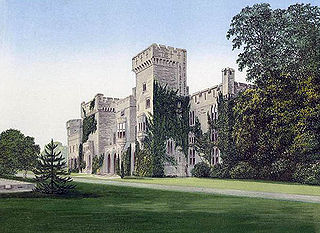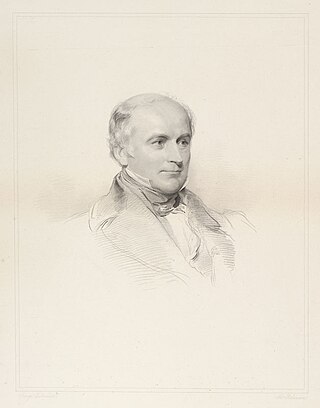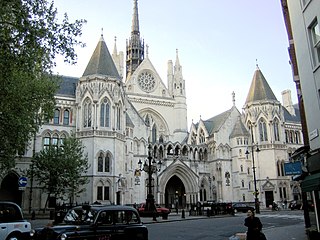Related Research Articles

A trust is a legal relationship in which the holder of a right gives it to another person or entity who must keep and use it solely for another's benefit. In the Anglo-American common law, the party who entrusts the right is known as the "settlor", the party to whom the right is entrusted is known as the "trustee", the party for whose benefit the property is entrusted is known as the "beneficiary", and the entrusted property itself is known as the "corpus" or "trust property". A testamentary trust is created by a will and arises after the death of the settlor. An inter vivos trust is created during the settlor's lifetime by a trust instrument. A trust may be revocable or irrevocable; an irrevocable trust can be "broken" (revoked) only by a judicial proceeding.
Joint wills and mutual wills are closely related terms used in the law of wills to describe two types of testamentary writing that may be executed by a married couple to ensure that their property is disposed of identically. Neither should be confused with mirror wills which means two separate, identical wills, which may or may not also be mutual wills.

An express trust is a trust created "in express terms, and usually in writing, as distinguished from one inferred by the law from the conduct or dealings of the parties." Property is transferred by a person to a transferee, who holds the property for the benefit of one or more persons, called beneficiaries. The trustee may distribute the property, or the income from that property, to the beneficiaries. Express trusts are frequently used in common law jurisdictions as methods of wealth preservation or enhancement.

A purpose trust is a type of trust which has no beneficiaries, but instead exists for advancing some non-charitable purpose of some kind. In most jurisdictions, such trusts are not enforceable outside of certain limited and anomalous exceptions, but some countries have enacted legislation specifically to promote the use of non-charitable purpose trusts. Trusts for charitable purposes are also technically purpose trusts, but they are usually referred to simply as charitable trusts. People referring to purpose trusts are usually taken to be referring to non-charitable purpose trusts.
In law a settlor is a person who settles property on trust law for the benefit of beneficiaries. In some legal systems, a settlor is also referred to as a trustor, or occasionally, a grantor or donor. Where the trust is a testamentary trust, the settlor is usually referred to as the testator. The settlor may also be the trustee of the trust or a third party may be the trustee. In the common law of England and Wales, it has been held, controversially, that where a trustee declares an intention to transfer trust property to a trust of which he is one of several trustees, that is a valid settlement notwithstanding the property is not vested in the other trustees.

English trust law concerns the protection of assets, usually when they are held by one party for another's benefit. Trusts were a creation of the English law of property and obligations, and share a subsequent history with countries across the Commonwealth and the United States. Trusts developed when claimants in property disputes were dissatisfied with the common law courts and petitioned the King for a just and equitable result. On the King's behalf, the Lord Chancellor developed a parallel justice system in the Court of Chancery, commonly referred as equity. Historically, trusts have mostly been used where people have left money in a will, or created family settlements, charities, or some types of business venture. After the Judicature Act 1873, England's courts of equity and common law were merged, and equitable principles took precedence. Today, trusts play an important role in financial investment, especially in unit trusts and in pension trusts. Although people are generally free to set the terms of trusts in any way they like, there is a growing body of legislation to protect beneficiaries or regulate the trust relationship, including the Trustee Act 1925, Trustee Investments Act 1961, Recognition of Trusts Act 1987, Financial Services and Markets Act 2000, Trustee Act 2000, Pensions Act 1995, Pensions Act 2004 and Charities Act 2011.

Knight v Knight (1840) 49 ER 58 is an English trusts law case, embodying a simple statement of the "three certainties" principle. This has the effect of determining whether assets can be disposed of in wills, or whether the wording of the will is too vague to allow beneficiaries to collect what appears on the face of the will to be theirs. The case has been followed in most common law jurisdictions.

The three certainties refer to a rule within English trusts law on the creation of express trusts that, to be valid, the trust instrument must show certainty of intention, subject matter and object. "Certainty of intention" means that it must be clear that the donor or testator wishes to create a trust; this is not dependent on any particular language used, and a trust can be created without the word "trust" being used, or even the donor knowing he is creating a trust. Since the 1950s, the courts have been more willing to conclude that there was intention to create a trust, rather than hold that the trust is void. "Certainty of subject matter" means that it must be clear what property is part of the trust. Historically the property must have been segregated from non-trust property; more recently, the courts have drawn a line between tangible and intangible assets, holding that with intangible assets there is not always a need for segregation. "Certainty of objects" means that it must be clear who the beneficiaries, or objects, are. The test for determining this differs depending on the type of trust; it can be that all beneficiaries must be individually identified, or that the trustees must be able to say with certainty, if a claimant comes before them, whether he is or is not a beneficiary.

Clayton Mordaunt Cracherode (1730–1799) was an English book and old master print collector, and a major benefactor of the British Museum.

Charitable trusts in English law are a form of express trust dedicated to charitable goals. There are a variety of advantages to charitable trust status, including exception from most forms of tax and freedom for the trustees not found in other types of English trust. To be a valid charitable trust, the organisation must demonstrate both a charitable purpose and a public benefit. Applicable charitable purposes are normally divided into categories for public benefit including the relief of poverty, the promotion of education, the advancement of health and saving of lives, promotion of religion and all other types of trust recognised by the law. There is also a requirement that the trust's purposes benefit the public, and not simply a group of private individuals.

The cy-pres doctrine in English law is an element of trusts law dealing with charitable trusts. The doctrine provides that when such a trust has failed because its purposes are either impossible or cannot be fulfilled, the High Court of Justice or Charity Commission can make an order redirecting the trust's funds to the nearest possible purpose. For charities with a worth under £5,000 and no land, the trustees may make the decision to redirect the trust's funds. The doctrine was initially an element of ecclesiastical law, coming from the Norman French cy près comme possible, but similar and possibly ancestral provisions have been found in Roman law, both in the Corpus Juris Civilis and later Byzantine law.
The creation of express trusts in English law must involve four elements for the trust to be valid: capacity, certainty, constitution and formality. Capacity refers to the settlor's ability to create a trust in the first place; generally speaking, anyone capable of holding property can create a trust. There are exceptions for statutory bodies and corporations, and minors who usually cannot hold property can, in some circumstances, create trusts. Certainty refers to the three certainties required for a trust to be valid. The trust instrument must show certainty of intention to create a trust, certainty of what the subject matter of the trust is, and certainty of who the beneficiaries are. Where there is uncertainty for whatever reason, the trust will fail, although the courts have developed ways around this. Constitution means that for the trust to be valid, the property must have been transferred from the settlor to the trustees.
In English law, a purpose trust is a trust created for the fulfillment of a purpose, not for the benefit of a person. These are normally considered invalid by the courts because they have no legally recognized beneficiaries, therefore nobody to enforce the trust, with the exception of charitable trusts, which are enforceable by the Attorney General as they represent the public interest. As well as charitable trusts, there are several exceptions to the rule against purpose trusts. If the requirement to fulfill a purpose is a request, rather than an obligation, the trust is valid; a trust will also be found valid if, while being for a purpose, it involves beneficiaries in some respect. Purpose trusts can also be valid if they are for the erection or maintenance of tombs and memorials, the maintenance of animals, and arguably the saying of masses, although these must all obey the rule against perpetuities and not continue for more than 21 years after the testator's death.
In English law, secret trusts are a class of trust defined as an arrangement between a testator and a trustee, made to come into force after death, that aims to benefit a person without having been written in a formal will. The property is given to the trustee in the will, and he would then be expected to pass it on to the real beneficiary. For these to be valid, the person seeking to enforce the trust must prove that the testator intended to form a trust, that this intention was communicated to the trustee, and that the trustee accepted his office. There are two types of secret trust — fully secret and half-secret. A fully secret trust is one with no mention in the will whatsoever. In the case of a half-secret trust, the face of the will names the trustee as trustee, but does not give the trust's terms, including the beneficiary. The most important difference lies in communication of the trust: the terms of a half-secret trust must be communicated to the trustee before the execution of the will, whereas in the case of a fully secret trust the terms may be communicated after the execution of the will, as long as this is before the testator's death.

Leahy v Attorney-General for New South Wales is an Australian and English trusts law case involving a charitable trust, heard by the High Court of Australia in 1958, and the Privy Council in 1959. The proceeding concerned the validity a gift to an unincorporated body, concluding that gifts in trust "cannot be made to a purpose or to an object" except for charitable circumstances.
The beneficiary principle is a policy of English trusts law, and trusts in Commonwealth jurisdictions, that trusts which do not have charitable objects, as under the UK Charities Act 2006 sections 2 and 3, and also do not make the trust property available for the benefit of defined people, are void.
Testate succession exists under the law of succession in South Africa.
Repington v Roberts-Gawen (1881–82) LR 19 Ch D 520 is a leading English trust law case, concerning the requirement of intention to create a trust, and the requisite level of certainty in the beneficiaries.

General Mordaunt Cracherode as a lieutenant-colonel was commanding officer of the marines during George Anson's voyage round the world. He held the post of Governor of Landguard Fort until he was appointed to succeed Lieutenant-General Churchill as Lieutenant Governor of Fort St. Philip in 1753.
Blackwell v Blackwell [1929] UKHL 1 is an English trusts law case, concerning the doctrine of secret trusts.